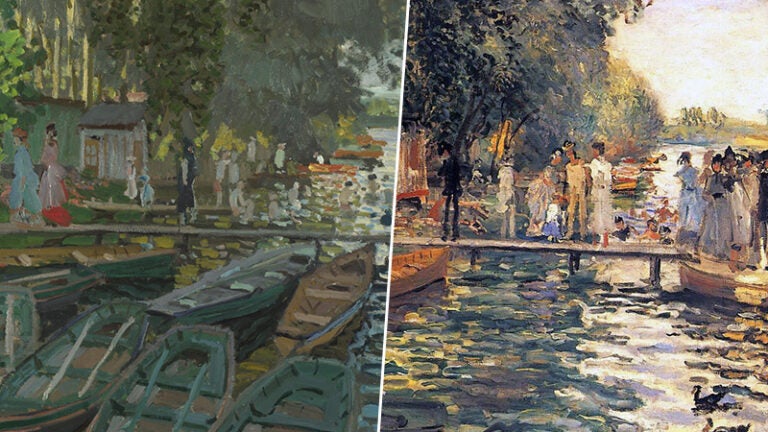
It may be an ordinary substance, but water has helped shape artistic masterpieces throughout the ages
In the summer afternoons of 1869, Claude Monet and Pierre-Auguste Renoir set up their easels overlooking La Grenouillère (The Frog Pond), a picturesque outdoor floating bar and restaurant on the River Seine, not far from Paris.
In short, quick brushstrokes, the two artists captured the play of sunlight on the water and Parisians enjoying the idyllic surroundings.
The water changed minute-by-minute, hour-by-hour as the sun sank and shadows dappled the river’s surface. Monet and Renoir painted the same subject from almost the same perspective, but their canvases showed very different depictions.
This was the start of a groundbreaking artistic movement eventually dubbed “impressionism,” which tossed out long-cherished rules about precision and realism in art and ushered in an era that instead valued an artist’s individual perception.
It was such compelling work that the formerly all-powerful French art institution L’Académie des Beaux Arts, which initially rejected these paintings, saw its influence decline as the impressionist movement eventually gained enormous popularity, leaving its detractors in the dust. Water was the catalyst for this emerging technique. Monet’s depiction of water reflections heralded a new way to think about brushwork and painting.
“When a painter paints water, they are studying the in-between of things. Water helps you to understand a new vision, a fresh way of understanding your own particular perspective,” says USC Dornsife’s Hector Reyes, associate professor (teaching) of art history. “Water complicates what we think we know about the world.”
Sturm und Drang

(Dune poster: Courtesy of Warner Bros.)
Humanity’s relationship with water has never been easy, which perhaps explains why it has played such an outsized role as a creative muse.
“Water is ambiguous. We need it to live, but too much of it can kill us,” says USC Dornsife’s Kristiana Willsey, lecturer of anthropology and folklore expert. Good rains make for fertile harvests. Too much rain and seeds, homes — even people — can be washed away.
This duality has inspired storytelling and art for millennia.
“Our earliest work of literature, the Epic of Gilgamesh, contains a great flood. The Bible’s Book of Genesis tells of a universal flood in which humanity gets washed away,” says Anthony Kemp, associate professor of English at USC Dornsife. Modern works like the 1995 film Waterworld or J. G. Ballard’s science fiction novel The Drowned World depict post-apocalyptic civilizations choked by rising water levels.
We’re equally gripped by the threat of water scarcity. In Frank Herbert’s science fiction novel Dune, water shortages help spark a planetary revolution while the neo-noir film Chinatown dramatized the heated fight for water rights in Los Angeles.
Legends of the Deep
Stories about water can be found in some of our earliest legends and folklore.
A substance that is often believed to have a mind of its own, water is also mysterious, cloaking what swims beneath its surface and reflecting and distorting faces in confusing shimmers. So, it’s hardly surprising, Willsey says, that water — and the weird creatures that inhabit it — have often inspired stories of disguise and impish independence.

(A Mermaid by John William Waterhouse.)
The Scottish “kelpie,” a mythical river-dwelling horse whose hooves face backwards, is believed to be able to shape-shift into human form, perhaps taking the guise of a beautiful young woman who then seduces a man to follow her into the depths.
In Celtic and Norse mythology, “selkies” are seal-like creatures who can turn into women if they shed their sealskin and it’s stolen by a man looking for a bride. The selkie may marry the man and bear him children, but if she ever finds her skin again, she will turn back into a seal and return to the sea.
And, of course, there are mermaids, which appear in the folklore of many cultures and are believed to either warn sailors of impending disaster or lure their ships to run aground on rocks.
“Water is more than just a purely positive or purely negative force,” says Willsey. “Mermaids, for example, were sometimes playful and sometimes evil.”
The Barren Sea
Ambiguous relationships with water are also found in the culture of the ancient Greeks who, despite their vast maritime achievements, surprisingly never felt fully at home on the sea. In his epic poem The Odyssey, set as a nautical voyage, Homer describes the ocean as “barren,” “boundless” and ominously “wine-dark.”
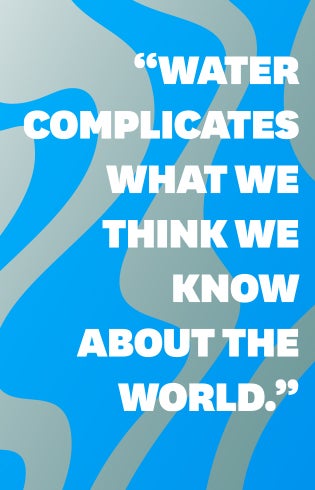
“The Greeks’ idea of the worst death was a shipwreck. It was considered a horrifying death, especially the fear of being eaten by fish,” says Vincent Farenga, professor of classics and comparative literature at USC Dornsife.
Despite their fears, the ocean still called powerfully to the Greeks. They constructed a vast fleet of ships and explored the Mediterranean, building colonies and empires that stretched from Russia to Egypt to Spain.
“The Greeks felt most at home on land, but the sea was the medium of their expansion and, in many ways, of their wealth and power,” says Farenga. “It’s also why their ideas could travel so rapidly and why they could absorb ideas from other cultures.”
The sea for the Greeks was also a place of passage, of moving from one zone to another. “Sometimes it represents going from one place that is very real and concrete and then arriving at another which is otherworldly,” says Farenga.
In The Odyssey, the entrance to the underworld was believed to lie beyond the sea. Thus, a passage over the ocean could also transport one from the living to the dead.
“We also see in the heroic stories male figures who grow from adolescence and immaturity into a mature hero, and it’s a sea voyage that is necessary in order to achieve that transformation,” says Farenga. “Poems like The Odyssey and Argonautika manage to utilize these motifs in infinite ways.
“Odysseus journeys to places that have an unreal quality, fantastic places that are inhabited by nonhuman creatures and beasts like the Cyclops. The Odyssey is the masterpiece of Greek storytelling when it comes to exploiting the symbolic potential of the sea.”
Dark passageways
Fast-forward approximately 2,600 years and the ocean as passageway is still a stalwart fixture in storytelling — this time peopled with swashbuckling pirates.
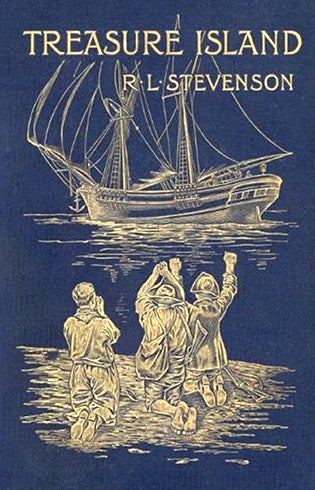
Treasure Island by Robert Louis Stevenson
The book Treasure Island by Robert Louis Stevenson, first serialized in a children’s magazine in 1881, told the story of a teenage boy who finds a map leading to buried pirate treasure and embarks on a quest.
If a 15-year-old running off to sea sounds nerve-racking to modern parents, it was par for the course in the 1880s. Boys as young as 12 were routinely drafted to serve in Britain’s Royal Navy, and books like Treasure Island helped romanticize these voyages.
Universally considered one of the world’s greatest works of literature, Herman Melville’s 1851 novel Moby Dickis the sailor Ishmael’s narrative of the obsessive quest of Ahab, captain of a whaling ship, for revenge on Moby Dick, the giant white sperm whale that bit off Ahab’s leg at the knee on a previous voyage. D. H. Lawrence called it “the greatest book of the sea ever written.”
In the end, all the crew but Ishmael perish in the quest, a somber reminder of the ocean’s power to vanquish even the most courageous of men.
“The sea becomes a testing of manliness, a place of adventure. It can be a place of horror, as in Moby Dick, or you can return again to your own realm after you’ve been through this baptism, transformed from timid to heroic,” says Kemp. “Or, as we see in the work of Joseph Conrad, the sea is the medium that takes us to colonialism.”
In Conrad’s Heart of Darkness, an English sailor grapples with the immorality of colonialism in Africa while working as a ferryboat captain. Conrad’s story was inspired partly by personal experience: He had been placed in command of a steamship on the Congo River after the captain fell ill.
As in ancient Greece, the conceptualization of the ocean as a passageway was also tied to the expansion of empire. Much of Europe had spent several centuries using the seas to build extensions of their nations abroad, moving ideas, goods and people through ocean routes. This included the use of slave ships to transport captured Africans to colonies in the New World.
“The phenomenon of slavery was not possible without control of the oceanic ‘Middle Passage’ from West Africa to the United States or to the Caribbean,” says Farenga. “This, too, was a journey from life to death — quite literally, as many did not survive passage.”
The passage has become a source of inspiration for some Black artists. The 1990s Detroit electronic duo Drexciya developed an Afrofuturist mythology tied to these watery depths.
The Drexciyans, the duo declared, were the descendants of enslaved pregnant women who had been tossed overboard. Their unborn children swam from the womb and grew into a powerful underwater civilization.
“Drexciya’s Black speculative, aquasonic concept albums were radical and transformative when they emerged in Detroit’s rich electronica scene, and have been key in Afrofuturist theorizations in art and scholarship since,” says Jonathan Leal, incoming assistant professor of English and currently a post-doctoral scholar and teaching fellow.
This mythos has since been depicted in books and graphic novels, and has inspired painting, poetry and calls for proposals to memorialize the 1.8 million Africans who perished while crossing the Atlantic as a result of the slave trade.
Imagine the unimaginable
Nowadays, we’re less likely to encounter new novels about plucky young people finding maturity at sea. Authors of such tales tend to write nostalgically about the past, rather than record present cultural beliefs. Patrick O’Brian’s popular Aubrey-Maturin series, the inspiration for the 2003 film Master and Commander, is set during the Napoleonic Wars of the early 19th century.
Perhaps in some ways this focus on the past is because, until relatively recently, we felt we had largely conquered water. Dams keep rivers contained, radar and satellites help guide us to port, and rain is tracked weeks ahead of time.
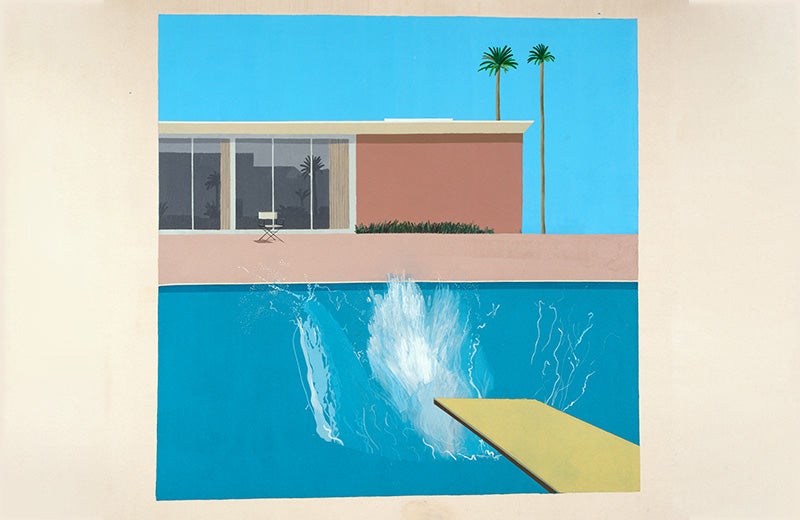
(A Bigger Splash by David Hockney © David Hockney Collection Tate, U.K.)
David Hockney’s 1960s and ’70s paintings of L.A. swimming pools portray water as blissful rectangles of orderly blue we can dive safely into. It is art that is more about poolside contemplation than the stormy voyages depicted in J. M. W. Turner’s dramatic 19th-century seascapes.
“For Hockney, the Hollywood swimming pool is a metaphor for our interest in reflection — the philosophical introspection at the side of a pool — and the filmic scene, made tangible and also illusory in paint,” says Reyes.
But water — one of Earth’s most powerful forces — is not so easily tamed. It now presents a greater risk to humanity than ever before. Climate change has heated our oceans, melted glaciers, intensified storms, increased the risk of tsunamis and turned once gentle streams into surging rivers.
The art world is responding. In 2014, Icelandic-Danish artist Olafur Eliasson transported 24 blocks of glacial ice, discovered floating near Greenland, to London, where he installed them in front of the Tate Modern to call attention to the melting ice caps. The Chinese American visual artist Mel Chin developed an app that enables users to see how New York City’s Times Square would look if it were flooded by rising seawater.
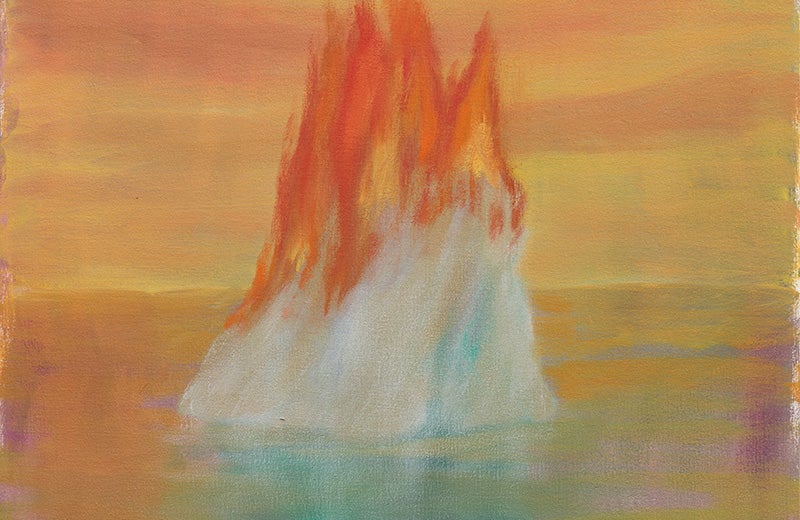
(The Unimaginable by Enrique Martínez Celaya.)
A recent painting, The Unimaginable by USC Dornsife Provost Professor of Humanities and Arts Enrique Martìnez Celaya, depicts an iceberg on fire.
Will this collision of water and art, like impressionism, help us construct a new vision of our world — one that this time will also inspire us to take the crucial steps we need to avoid disaster?
Our planet surely hopes so.